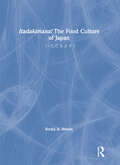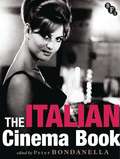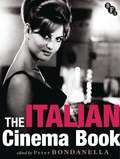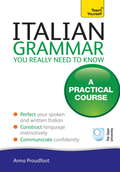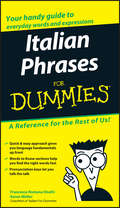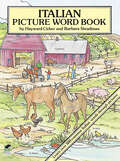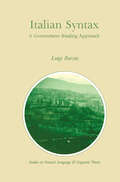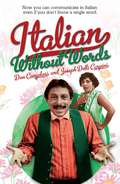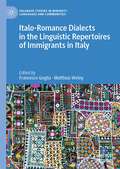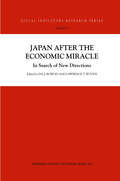- Table View
- List View
Itadakimasu! The Food Culture of Japan: いただきます!
by Becky A. BrownItadakimasu! The Food Culture of Japan is designed as a first- or second-year college course in Japanese culture for students who have little to no background in the Japanese language, culture, literature, or history. Unlike any other culture text, Itadakimasu! offers a unique approach to learning about culture through a country’s cuisine. This account takes students on an exciting journey into the world of Japanese food culture, both past and present, exploring themes such as regional specialties, annual festivals, traditional foodways, prominent tea masters, culinary expressions, restaurant menus, dining etiquette, mealtime customs, and culinary aesthetics. Itadakimasu! also addresses current events in the food industry and agribusiness, health and nutrition, dieting trends, fast food, and international and Western influences. Enhancing this wealth of cultural material are autobiographical essays written by guest contributors and varied literary excerpts featuring food themes across different genres in literature spanning many centuries. Each of the readings is supplemented by general comprehension questions followed by more probing queries calling on critical and analytical thinking to methodically guide students from a cursory understanding of a new culture to reflections on their own experiences and other world cultures. Resources also highlight food-centric films so that students can witness what they are learning about in an authentic cultural context. Furthermore, teachers and students alike can enjoy food tasting labs in the classroom, fostering yet another authentic experience for the students. With the intention of reaching a broad audience of students majoring or minoring in Japanese or Asian Studies, or students learning English as a Foreign Language or English for Specific Purposes, Itadakimasu! could also be useful for composition and conversation courses and the Writing Across the Curriculum series or as a supplement for 'Four Skills' Japanese language courses and introductory Japanese literature offerings. Above all, its multifaceted design with a broad spectrum of self-contained sections welcomes individual teaching styles and preferences. Itadakimasu! paints an appetizing image of Japan’s society with just a dash of culture, a pinch of language, and a taste of literature to tempt the palate of students new to the study of Japan. Meant to enhance the regular curriculum, this innovative approach to learning about Japan suggests that the culinary world can lend an insightful view into a country’s culture. Historical and contemporary foodways are universal elements common to all cultures, making the subject matter inherently relatable. An Instructors Manual containing sample syllabi, learning outcomes, handout templates, study guides, background content and more is available at www.routledge.com/9780367903572.
The Italian Academies 1525-1700: Networks of Culture, Innovation and Dissent (Legenda)
by Jane E. Everson Denis V. Reidy Lisa SampsonThe intellectual societies known as Academies played a vital role in the development of culture, and scholarly debate throughout Italy between 1525-1700. They were fundamental in establishing the intellectual networks later defined as the ‘République des Lettres’, and in the dissemination of ideas in early modern Europe, through print, manuscript, oral debate and performance. This volume surveys the social and cultural role of Academies, challenging received ideas and incorporating recent archival findings on individuals, networks and texts. Ranging over Academies in both major and smaller or peripheral centres, these collected studies explore the interrelationships of Academies with other cultural forums. Individual essays examine the fluid nature of academies and their changing relationships to the political authorities; their role in the promotion of literature, the visual arts and theatre; and the diverse membership recorded for many academies, which included scientists, writers, printers, artists, political and religious thinkers, and, unusually, a number of talented women. Contributions by established international scholars together with studies by younger scholars active in this developing field of research map out new perspectives on the dynamic place of the Academies in early modern Italy. The publication results from the research collaboration ‘The Italian Academies 1525-1700: the first intellectual networks of early modern Europe’ funded by the Arts and Humanities Research Council and is edited by the senior investigators.
The Italian Academies 1525-1700: Networks of Culture, Innovation and Dissent (Legenda)
by Jane E. Everson Denis V. Reidy Lisa SampsonThe intellectual societies known as Academies played a vital role in the development of culture, and scholarly debate throughout Italy between 1525-1700. They were fundamental in establishing the intellectual networks later defined as the ‘République des Lettres’, and in the dissemination of ideas in early modern Europe, through print, manuscript, oral debate and performance. This volume surveys the social and cultural role of Academies, challenging received ideas and incorporating recent archival findings on individuals, networks and texts. Ranging over Academies in both major and smaller or peripheral centres, these collected studies explore the interrelationships of Academies with other cultural forums. Individual essays examine the fluid nature of academies and their changing relationships to the political authorities; their role in the promotion of literature, the visual arts and theatre; and the diverse membership recorded for many academies, which included scientists, writers, printers, artists, political and religious thinkers, and, unusually, a number of talented women. Contributions by established international scholars together with studies by younger scholars active in this developing field of research map out new perspectives on the dynamic place of the Academies in early modern Italy. The publication results from the research collaboration ‘The Italian Academies 1525-1700: the first intellectual networks of early modern Europe’ funded by the Arts and Humanities Research Council and is edited by the senior investigators.
Italian All-in-One For Dummies
by Antonietta Di Pietro Francesca Romana Onofri Teresa L. Picarazzi Karen Antje Möller Daniela Gobetti Beth Bartolini-SalimbeniLearn to speak Italian like a native? Easy. Italian All-in-One For Dummies appeals to those readers looking for a comprehensive, all-encompassing guide to mastering the Italian language. It contains content from all For Dummies Italian language instruction titles, including Italian For Dummies, Intermediate Italian For Dummies, Italian Verbs For Dummies, Italian Phrases For Dummies, Italian Grammar For Dummies, and Italian For Dummies Audio Set. Offers readers interested in learning Italian a valuable reference to all aspects of this popular language The content appeals to students, travelers, and businesspeople who visit Italian-speaking countries An online companion site allows you to download audio tracks allows for more practice opportunities, as well as additional content empowering you to speak Italian like a native Whether you're a pure beginner or have some familiarity with the language, Italian All-in-One For Dummies, with downloadable audio practice online, is your ticket to speaking, and writing, Italian.
Italian All-in-One For Dummies
by Antonietta Di Pietro Francesca Romana Onofri Teresa L. Picarazzi Karen Antje Möller Daniela Gobetti Beth Bartolini-SalimbeniLearn to speak Italian like a native? Easy. Italian All-in-One For Dummies appeals to those readers looking for a comprehensive, all-encompassing guide to mastering the Italian language. It contains content from all For Dummies Italian language instruction titles, including Italian For Dummies, Intermediate Italian For Dummies, Italian Verbs For Dummies, Italian Phrases For Dummies, Italian Grammar For Dummies, and Italian For Dummies Audio Set. Offers readers interested in learning Italian a valuable reference to all aspects of this popular language The content appeals to students, travelers, and businesspeople who visit Italian-speaking countries An online companion site allows you to download audio tracks allows for more practice opportunities, as well as additional content empowering you to speak Italian like a native Whether you're a pure beginner or have some familiarity with the language, Italian All-in-One For Dummies, with downloadable audio practice online, is your ticket to speaking, and writing, Italian.
The Italian Cinema Book
by Peter BondanellaTHE ITALIAN CINEMA BOOK is an essential guide to the most important historical, aesthetic and cultural aspects of Italian cinema, from 1895 to the present day. With contributions from 39 leading international scholars, the book is structured around six chronologically organised sections:THE SILENT ERA (1895–22)THE BIRTH OF THE TALKIES AND THE FASCIST ERA (1922–45)POSTWAR CINEMATIC CULTURE (1945–59)THE GOLDEN AGE OF ITALIAN CINEMA (1960–80)AN AGE OF CRISIS, TRANSITION AND CONSOLIDATION (1981 TO THE PRESENT)NEW DIRECTIONS IN CRITICAL APPROACHES TO ITALIAN CINEMAAcutely aware of the contemporary 'rethinking' of Italian cinema history, Peter Bondanella has brought together a diverse range of essays which represent the cutting edge of Italian film theory and criticism. This provocative collection will provide the film student, scholar or enthusiast with a comprehensive understanding of the major developments in what might be called twentieth-century Italy's greatest and most original art form.
The Italian Cinema Book
THE ITALIAN CINEMA BOOK is an essential guide to the most important historical, aesthetic and cultural aspects of Italian cinema, from 1895 to the present day. With contributions from 39 leading international scholars, the book is structured around six chronologically organised sections:THE SILENT ERA (1895–22)THE BIRTH OF THE TALKIES AND THE FASCIST ERA (1922–45)POSTWAR CINEMATIC CULTURE (1945–59)THE GOLDEN AGE OF ITALIAN CINEMA (1960–80)AN AGE OF CRISIS, TRANSITION AND CONSOLIDATION (1981 TO THE PRESENT)NEW DIRECTIONS IN CRITICAL APPROACHES TO ITALIAN CINEMAAcutely aware of the contemporary 'rethinking' of Italian cinema history, Peter Bondanella has brought together a diverse range of essays which represent the cutting edge of Italian film theory and criticism. This provocative collection will provide the film student, scholar or enthusiast with a comprehensive understanding of the major developments in what might be called twentieth-century Italy's greatest and most original art form.
Italian For Dummies
by Francesca Romana Onofri Karen Antje Möller Teresa L. PicarazziThe fun and easy way to take your Italian language skills to the next level The tips, techniques, and information presented here give students, travelers, and businesspeople a primer on how to speak Italian. Complete with updates, a bonus CD, and the traditional For Dummies user-friendly format, this new edition of Italian For Dummies gives you reliable lessons, practice, and language learning techniques for speaking Italian with ease and confidence. Featuring a revamped, user-friendly organization that builds on your knowledge and ability, Italian For Dummies offers expanded coverage of the necessary grammar, major verb tenses, and conjugations that beginners need to know. Plus, you'll get a fully updated and expanded audio CD that includes real-life conversations; a refreshed and expanded mini-dictionary; more useful exercises and practice opportunities; and more. Builds on your skills and ability as you learn Covers the grammar, verb tenses, and conjugations you need to know Includes a mini-dictionary Audio CD includes real-life conversations If you're looking to reach a comfort level in conversational Italian, Italian For Dummies gets you comfortably speaking this Romantic language like a native.
Italian For Dummies
by Francesca Romana Onofri Karen Antje Möller Teresa L. PicarazziThe fun and easy way to take your Italian language skills to the next level The tips, techniques, and information presented here give students, travelers, and businesspeople a primer on how to speak Italian. Complete with updates, a bonus CD, and the traditional For Dummies user-friendly format, this new edition of Italian For Dummies gives you reliable lessons, practice, and language learning techniques for speaking Italian with ease and confidence. Featuring a revamped, user-friendly organization that builds on your knowledge and ability, Italian For Dummies offers expanded coverage of the necessary grammar, major verb tenses, and conjugations that beginners need to know. Plus, you'll get a fully updated and expanded audio CD that includes real-life conversations; a refreshed and expanded mini-dictionary; more useful exercises and practice opportunities; and more. Builds on your skills and ability as you learn Covers the grammar, verb tenses, and conjugations you need to know Includes a mini-dictionary Audio CD includes real-life conversations If you're looking to reach a comfort level in conversational Italian, Italian For Dummies gets you comfortably speaking this Romantic language like a native.
Italian Grammar You Really Need to Know: Teach Yourself (Teach Yourself Language Reference)
by Anna ProudfootComprehensive and clear explanations of key grammar patterns and structures are reinforced and contextualized through authentic materials. You will not only learn how to construct grammar correctly, but when and where to use it so you sound natural and appropriate. "Italian Grammar You Really Need to Know will help you gain the intuition you need to become a confident communicator in your new language.
Italian Phrases For Dummies (For Dummies)
by Francesca Romana Onofri Karen Antje MöllerEveryday conversations in Italian made easy Italy is a perennially popular destination for Americans, with three cities (Florence, Rome, and Venice) among the top ten in Travel & Leisure's 2003 "World's Best Cities" poll. This concise, easy-to-use guide helps travelers and students get up to speed fast on conversational Italian, showcasing the most commonly used words and phrases. Francesca Romana Onofri is an Italian translator and teacher. Karen Moller is a writer who has worked on several Italian-language projects for Berlitz.
Italian Picture Word Book
by Barbara Steadman Hayward CirkerHere’s a pleasant and effective way for students of Italian to build and strengthen vocabulary skills. The book consists of 15 carefully rendered scenes (14 double-page and one single-page), each devoted to a different theme or topic.Lo zoo: At the zooLa fattoria: On the farmLa camera di una ragazza: Girl’s bedroomLa camera di un ragazzo: Boy’s bedroomL’aula scolastica: ClassroomIl soggiorno: Living roomIl bagno: BathroomL’ora di pranzo: At dinnerIl supermercato: SupermarketLa spiaggia: At the beach… and five more.Each illustration contains dozens of common objects, clearly labeled in Italian. By studying the illustrations, students can learn over 500 words for common household items, clothing, foods, vehicles, furniture, names of animals, parts of the body, types of stores and public buildings, and much more.To help reinforce words and meanings, all the scenes in this book are ideal for coloring. In addition, a complete list of Italian words (with definite articles) and English translations will be found at the back of the book. The result is an attractive and useful language resource that will appeal to any student of basic Italian, child or adult.
Italian Syntax: A Government-Binding Approach (Studies in Natural Language and Linguistic Theory #1)
by L. BurzioIn the course of our everyday lives, we generally take our knowledge of language for granted. Occasionally, we may become aware of its great practical importance, but we rarely pay any attention to the formal properties that language has. Yet these properties are remarkably complex. So complex that the question immediately arises as to how we could know so much. The facts that will be considered in this book should serve well to illustrate this point. We will see for example that verbs like arrivare 'arrive' and others like telefonare 'telephone', which are superficially similar, actually differ in a large number of respects, some fairly well known, others not. Why should there be such differencces. we may ask. And why should it be that if a verb behaves like arrivare and unlike tetefonare in one respect. it will do so in all others consistently, and how could everyone know it? To take another case, Italian has two series of pronouns: stressed and unstressed. Thus, for example, alongside of reflexive se stesso 'himself which is the stressed form. one finds si which is unstressed but otherwise synonymous. Yet we will see that the differences between the two could not simply be stress versus lack of stress, as their behavior is radically different under a variety of syntactic conditions.
Italian Without Words
by Don Cangelosi Joseph Delli CarpiniYou don't need words to speak Italian! All you really need is this unique "phrase book" of Italian body language. It's the fastest, and funniest, way to learn Italian ever published. Now, even if you don't know a single word of Italian, you can learn the most common greetings, dining small talk, bargaining tricks, hot vows of love, vicious threats and blood curdling curses. This book shows you how. There's no faster or funnier way to learn how to communicate in Italian.You don't need words to speak Italian! You don't have to study Italian or travel to Italy to communicate like a true paesano. All you really need is this unique "phrase book" of Italian body language. It's the fastest, and funniest, way to learn Italian ever published. Now, even if you don't know a single word of Italian, you can learn the most common greetings, dining small talk, bargaining tricks, hot vows of love, vicious threats and blood curdling curses. This book shows you how. There's no faster or funnier way to learn how to communicate in Italy, Italian restaurants, with your grandparents or your friends.
Italian Without Words
by Don Cangelosi Joseph Delli CarpiniYou don't need words to speak Italian. All you really need is this unique "phrase book" of the most common Italian expressions, complete with authentic Italian gestures and body language. There's no faster or funnier way to learn how to communicate in Italy, Italian restaurants, with your grandparents or your friends. You don't need words to speak Italian. You don't have to study Italian or travel to Italy to communicate like a true paesano. All you really need is this unique "phrase book" of the most common Italian expressions, complete with authentic Italian gestures and body language. It's the fastest and funniest way to learn Italian ever published. Now, even if you don't know a single word of Italian, you can learn the most common greetings and expressions, dinner-table comments, hot vows of love, bargaining tricks, insults, threats and curses. This book shows you how. There's no faster or funnier way to learn how to communicate in Italy, Italian restaurants, with your grandparents or your friends.
Italian Workbook For Dummies
by Teresa L. PicarazziLearning Italian is easy with Dummies Italian Workbook For Dummies is for beginners who want to get started learning Italian. Packed with foundational grammar and integrated vocab, Italian Workbook For Dummies will set new language learners on their way to a wonderful experience learning this beautiful romance language. This book provides valuable practice lessons and exercises so that you can learn to write and communicate in Italian with confidence. Italian Workbook For Dummies is also an excellent supplement for any student looking to boost their classroom learning. With the tried-and-true expertise of Dummies, you'll move through the Italian basics with ease. Get introduced to the Italian language, including basic grammar and pronunciation Complete exercises to improve your ability to write and speak in Italian Learn important phrases for travelling, doing business, and studying in Italy Build your vocabulary, discover common slang, and learn authentic expressionsThis is the perfect Dummies guide for those who are brand new to the Italian language, regardless of age or background. Gain the confidence you need to interact in Italiano!
Italian Workbook For Dummies
by Teresa L. PicarazziLearning Italian is easy with Dummies Italian Workbook For Dummies is for beginners who want to get started learning Italian. Packed with foundational grammar and integrated vocab, Italian Workbook For Dummies will set new language learners on their way to a wonderful experience learning this beautiful romance language. This book provides valuable practice lessons and exercises so that you can learn to write and communicate in Italian with confidence. Italian Workbook For Dummies is also an excellent supplement for any student looking to boost their classroom learning. With the tried-and-true expertise of Dummies, you'll move through the Italian basics with ease. Get introduced to the Italian language, including basic grammar and pronunciation Complete exercises to improve your ability to write and speak in Italian Learn important phrases for travelling, doing business, and studying in Italy Build your vocabulary, discover common slang, and learn authentic expressionsThis is the perfect Dummies guide for those who are brand new to the Italian language, regardless of age or background. Gain the confidence you need to interact in Italiano!
Italienische Grammatik für Dummies (Für Dummies)
by Rita LinhartSteht der nächste Test an, haben Sie italienische Kollegen, mit denen Sie sich austauschen wollen, oder möchten Sie in Ihrem Italienurlaub mehr als einfach nur "Grazie" sagen können? Grammatik ist nicht jedermanns Sache und die italienische Grammatik macht es einem auch nicht immer leicht. Rita Linhart kennt die Nöte der Lernenden und die Fallen der italienischen Grammatik, in die sie häufig hineintappen. Leicht verständlich, mit einer Prise Humor und anhand vieler Beispiele und Informationen zu Land und Leuten erklärt sie alles über Artikel und Pronomen, Adjektive und Adverbien, Fragestellung und Verneinung, die Zeiten und die Satzstellung. Am Ende eines jeden Kapitels gibt es Übungen, die das Gelernte noch einmal wiederholen. Tabellen der wichtigsten italienischen Verben bieten ganz Eiligen alle Konjugationen auf einen Blick. So sind Sie für den nächsten Test gerüstet, können mit Ihren italienischen Kollegen über zukünftige Projekte sprechen oder einfach nur unbeschwert im Italienurlaub parlieren.
Italo-Romance Dialects in the Linguistic Repertoires of Immigrants in Italy (Palgrave Studies in Minority Languages and Communities)
by Francesco Goglia Matthias WolnyThis edited book brings together experts on the sociolinguistics of immigration with a focus on the Italo-Romance dialects. Sociolinguistic research on immigrant communities in Italy has widely studied the acquisition and use of Italian as L2 by first-generation immigrants, the maintenance of immigrant languages and code-switching between Italian and the immigrant languages. However, these studies have mostly ignored or neglected to investigate immigrant speakers’ use of Italo-Romance dialects, their awareness of the sociolinguistic situation of majority and minority languages, and their attitudes towards them. Given the important role of Italo-Romance dialects in everyday communication and as a marker of regional identity, this book aims to fill this gap and understand more about the role that these languages play in the linguistic repertoire of immigrants. This book will be of interest to students and scholars of sociolinguistics, minority languages, multilingualism, migration, and social anthropology.
Japan after the Economic Miracle: In Search of New Directions (Social Indicators Research Series #3)
by Paul Bowles and Lawrence T. WoodsAs Japan comes to grips with a decade of economic malaise after its spectacular post-war growth record, how will Japanese society react? Contributors to this volume examine the challenges ahead for Japan in the fields of politics, economics, sociology, environment and business. This multidisciplinary inquiry looks for areas of continuity and for new directions in government, business and social policy and practice. Also examined is how Western students should approach the study of Japan; what new directions should institutions take to ensure that students learn about the `real' Japan? Written by Canadian academics, the articles in this volume will be of interest to academics and policy-makers studying or teaching about contemporary Japan.
Japan on the Jesuit Stage: Two 17th-Century Latin Plays with Translation and Commentary (Bloomsbury Neo-Latin Series: Early Modern Texts and Anthologies)
by Akihiko WatanabeThe Jesuits were a major source of European information on Japan from the late 16th to early 17th century. Not only were they active missionaries but they also produced linguistic, religious and cultural tracts, regional chronicles, as well as hundreds of Latin plays written in imitation of classical Greco-Roman theatre but set in Japan. An intriguing yet underexplored segment of Jesuit school theatre is that which stages non-classical, non-Western subjects such as Japan, and this volume is the first to present Latin texts of two of these plays alongside full English translations, commentaries and an extensive introduction. The plays in question - Martyrs of Japan and Victor the Japanese - were performed in Koblenz and Munich, in 1625 and 1665 respectively, and are collated from original 17th-century manuscripts for this edition. They were based on specific events which took place in Japan in 1597 and 1613, and their main characters are historically attested Japanese Catholic converts and their pagan peers. The juxtaposition of the Latin texts and original English translations makes the plays newly accessible to a wide readership, shedding light on the ways in which Western classical humanism rooted in ancient Mediterranean theatre became intertwined with momentous historical developments across the globe to produce these unique spectacles. The introduction and commentary examine the historical, cultural and literary contexts and provide guidance on interpretative and stylistic issues, allowing for a full appreciation of the plays in which pagan classical, Christian, early modern European and Japanese elements come together.
Japan on the Jesuit Stage: Two 17th-Century Latin Plays with Translation and Commentary (Bloomsbury Neo-Latin Series: Early Modern Texts and Anthologies)
by Akihiko WatanabeThe Jesuits were a major source of European information on Japan from the late 16th to early 17th century. Not only were they active missionaries but they also produced linguistic, religious and cultural tracts, regional chronicles, as well as hundreds of Latin plays written in imitation of classical Greco-Roman theatre but set in Japan. An intriguing yet underexplored segment of Jesuit school theatre is that which stages non-classical, non-Western subjects such as Japan, and this volume is the first to present Latin texts of two of these plays alongside full English translations, commentaries and an extensive introduction. The plays in question - Martyrs of Japan and Victor the Japanese - were performed in Koblenz and Munich, in 1625 and 1665 respectively, and are collated from original 17th-century manuscripts for this edition. They were based on specific events which took place in Japan in 1597 and 1613, and their main characters are historically attested Japanese Catholic converts and their pagan peers. The juxtaposition of the Latin texts and original English translations makes the plays newly accessible to a wide readership, shedding light on the ways in which Western classical humanism rooted in ancient Mediterranean theatre became intertwined with momentous historical developments across the globe to produce these unique spectacles. The introduction and commentary examine the historical, cultural and literary contexts and provide guidance on interpretative and stylistic issues, allowing for a full appreciation of the plays in which pagan classical, Christian, early modern European and Japanese elements come together.
Japanese at Work: Politeness, Power, And Personae In Japanese Workplace Discourse (Communicating In Professions And Organizations Ser.)
by Haruko Minegishi Cook Janet S. Shibamoto-SmithPoliteness, Power, And Personae In Japanese Workplace Discourse
Japanese Character Writing For Dummies
by Hiroko M. Chiba Vincent GrepinetLearn to write 100 Japanese characters If you want to join the ranks of more than 128 million speakers of Japanese worldwide, this book should be your first stop! Whether studying for school, business, or travel, learning to write the Japanese Kanji characters is essential to gain a working knowledge of this language. Japanese is considered to be the most complicated writing system in the world, with tens of thousands of characters. But with Japanese Character Writing For Dummies, you’ll find easy step-by-step instructions for writing the first 100 Japanese Kanji characters with ease. Includes online bonus content featuring videos, downloadable flashcards, and printable writing pages Offers easy-to-follow instruction for writing 100 Japanese characters Helps you take your understanding of the language to a new level Shows you how to use the written word to communicate with native speakers Learning to write Japanese Kanji characters is fun — and now it’s fast and easy too!
Japanese Character Writing For Dummies
by Hiroko M. Chiba Vincent GrepinetLearn to write 100 Japanese characters If you want to join the ranks of more than 128 million speakers of Japanese worldwide, this book should be your first stop! Whether studying for school, business, or travel, learning to write the Japanese Kanji characters is essential to gain a working knowledge of this language. Japanese is considered to be the most complicated writing system in the world, with tens of thousands of characters. But with Japanese Character Writing For Dummies, you’ll find easy step-by-step instructions for writing the first 100 Japanese Kanji characters with ease. Includes online bonus content featuring videos, downloadable flashcards, and printable writing pages Offers easy-to-follow instruction for writing 100 Japanese characters Helps you take your understanding of the language to a new level Shows you how to use the written word to communicate with native speakers Learning to write Japanese Kanji characters is fun — and now it’s fast and easy too!
